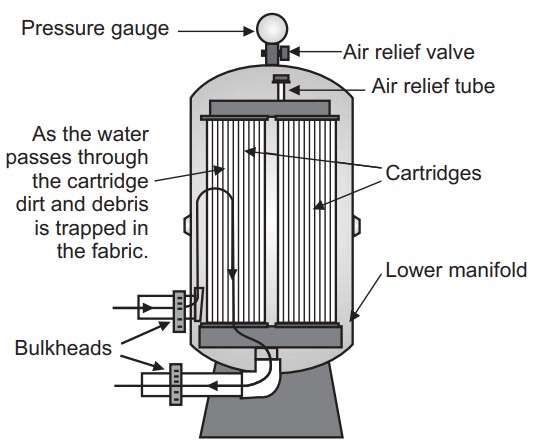Cartridge filters are fabric or polymer-based filters designed primarily to remove particulate material from fluids. They are usually rigid or semi-rigid and are manufactured by affixing the fabric or polymer to a central core. Pre-formed cartridge filters of all sizes are one of the simplest and most commonly-found means of removing particulate material from water supplies.
Table of Contents
Principle of Cartridge Filters
The main principle of this filter is physical filtration. These systems work by pushing water from the reservoir into the cylinder. A cylinder collects the larger debris, and the secondary filter catches anything that the first one may have missed. The water passes through the polyester filters, and dirt gets stuck on the screen, allowing clean water to pass by. The liquid to be filtered is imported, and clear liquid flows to the discharge port. The drainage inlet filter size, structure, and size of the filter depend on the design flow and the filter medium characteristics of the liquid.
Construction of Cartridge Filters
It is designed to remove solid particulate material from the water. These may be constructed in a number of different ways and from various materials, including pleated paper or fiber, plastics such as polypropylene or nylon, cellulose, membranes, fiberglass, ceramics, etc. It is characterized by a composite structure of the filter cartridge, saving the volume of the cylinder. It is easy to clean and maintain and can be designed to a pressure of up to 5 M.Pa and 280 °C temperature. The shell is made of carbon steel or stainless steel. Filter cartridge housings consist of single cartridges or up to hundreds of cartridges, as shown in the figure below.

The housing is sized based on the flow rate, the viscosity of a liquid, the filtration efficiency required, and the allowable clean differential pressure drop. The cartridge filter is used in the chemical industry to filter 50 – 150 µ particles of the media. These filters are rated by the maximum size of particles they allow to pass through. A “nominal” rating means that a stated percentage of pores in the filter is smaller than a specified size. An “absolute” rating states the maximum pore size that may be found anywhere on the filter. These filters are often installed in series in descending order of pore size to maximize removal efficiency and protect downstream filters or other treatment processes.
Working of Cartridge Filters
When the liquid through the cylinder enters the basket, the solid impurity particles are blocked in the filter basket, and clean fluid through the filter basket is discharged from the filter outlet. For cleaning, the bottom of the head plung is unscrewed to drain the fluid after removing the flange cover. After cleaning, the components are reloaded. Therefore, the use of maintenance is very convenient. Solid material suspended in the water gets trapped on the cartridge filter. The filter is rated to remove particles of a certain size. A typical choice would be a 20 µ filter followed by a 5 and/or 1 µ filter, but the exact choice depends on the quality of the supply and the substance(s) that need to be removed. The filter should be clearly marked with its size rating.
Advantages of Cartridge Filters
(i) Cartridge filters are relatively cheap, compact, and requiring minimal maintenance other than changing the cartridge.
(ii) These filters are disposable and easily replaceable.
(iii) Cartridge filter systems are modular and can theoretically accommodate any flow
rate by increasing or decreasing the number of filters or filter arrays.
(iv) Being cheaper, they are suitable for their use in smaller water systems.
(v) These filters are of high quality with reasonable structure.
(vi) They have higher flow rates.
(vii) They are easy to maintain and assemble, with high filter accuracy.
(viii) They require low maintenance and oversight.
Disadvantages:
(i) As cartridge filters are not backwashed, they are simply replaced once they become dirty or blocked.
(ii) The use of coagulants or a pre-coat with a cartridge filter is not usually recommended.
(iii) Cartridge filtration for water treatment is limited by two sources namely; water quality and system size.
Applications
(i) It is used in the chemical and petrochemical production of weak corrosive materials, such as water, oil, ammonia, hydrocarbons, and so on.
(ii) In the chemical production of corrosive materials, such as: caustic soda, soda ash, concentrated sulphuric acid, carbonic acid, uronic acid, and so on.
(iii) In the case of the cooling of low-temperature materials, such as: liquid methane, liquid ammonia, liquid oxygen, and various refrigerants.
(iv) In food production of the health requirements materials, such as: beer, beverages, dairy products, syrup, and so on.
(v) In pharmaceutical production of tissue culture media, enzymes, aqueous solutions, chemical and reagent purification, immunological and cosmetic products.
(vi) It can be used to remove general debris such as leaves or sediment, or chemical precipitates that have been encouraged to form in the water (for example,e by oxidation) to enable their removal.
Plate and Frame Filter Press